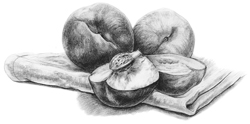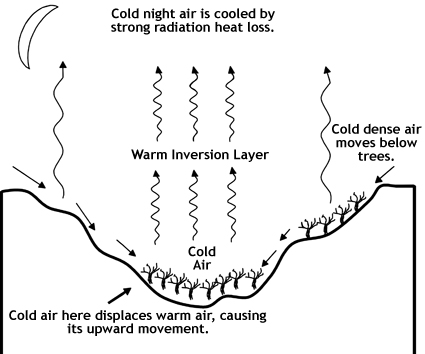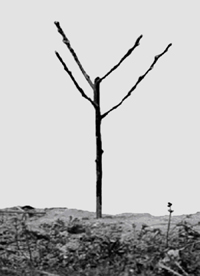
Site Selection
Essential to successful peach tree culture is selection of a location that provides adequate sunlight, cold air drainage and water drainage.
To produce a high quality peach crop, trees need full sunlight at least 80 percent of the day. Full sunlight supports good fruit health by allowing fruit and leaves to dry, reducing the opportunity for pathogens. Plant trees in sites that allow colder, heavier air to drain away from the tree’s fruiting zone to lower ground below the orchard. The incidence of frost nights during the spring when flowers or developing fruit are vulnerable to radiation heat loss from the fruiting zone causes a radiation freeze (Fig. 1)
 |
Figure 1. Radiation freezes are characterized by:
|
The average last freeze date is delayed more than five weeks by elevation and solar orientation. Hilltops and southern slopes are significantly warmer than northern slopes and low areas. Applying overhead irrigation throughout the freeze event can protect against radiation freeze by maintaining tree fruit tissues above critical temperatures. As water freezes, it releases heat to plant tissue. Since many orchards cannot employ this strategy, proper placement of the orchard site can reduce the vulnerability of fruit and flowers to frost. Placement of fruit trees on a grade that allows the drainage of cold air to lower areas will provide protection on frosty nights.
Another type of freeze, an advective freeze, can destroy shoots and branches as well as developing flowers and fruit. Advective freezes are characterized by cold, dry air masses that move south and east from Canada. Usually these freezes arrive with high winds and are generally more common in the winter. If this type of freeze occurs during spring, it can dessicate non-dormant buds or flowers, reducing fruit set. Unfortunately, the high wind speeds (above 8-10 miles per hour) prevent the effective use of irrigation.
Although fruit trees can be grown on a range of soil types from sand to clay, they thrive best in sandy loam topsoil that is 18 to 24 inches deep underlaid with a brightly colored, well-drained clay subsoil. Shallow or poorly drained soils will produce smaller, weaker trees with lower yields. It is essential that the soil profile have adequate nutrient content and water-holding capacities throughout. Permeability of the soil profile to water and air is required for proper root growth. A dull-colored soil profile (blue to gray) suggests poor soil drainage. Flooding for 72 hours during the summer can kill peach trees. Flooding for shorter periods can compromise the tree by making it susceptible to root pathogens. It is particularly important that fruit trees be planted in well-drained soils or on beds raised 1 to 2 feet above the typical soil elevation in poorly drained soils or in soils prone to flooding. Since soil moisture can be limiting in some seasons, you need to irrigate bedded trees or rocky sites that tend to be excessively dry.
While fruit trees can be protected against a number of pathogens, several can be avoided through proper site selection. Knowing the history of your site may immediately rule it out as an appropriate orchard locale. If the site is known to have had oak root rot, avoid it entirely or, if it is known to be infested with crown gall, use a product named No-Gall™ to protect the tree from the organism that infests the soil. Root knot and ring nematodes destroy fruit trees within 5 years of planting them. Contact your county extension agent for instructions to test your proposed site for nematodes. If nematodes are present, peach trees to be planted should be on the Guardian™ rootstock.
Site Preparation
A judicious approach to orchard installation will usually result in earlier returns and longer tree survival. Begin preparation of the site one year prior to its planting. Proper weed and weed seed removal by herbicide application and fumigation will reduce the level of herbicide use needed once the orchard is established.
The soil should be subsoiled and turned to disturb or remove any compacted layers to ensure adequate drainage; then test the soil. If the nematode test indicates the presence of root knot nematode, Meloidogyne spp., ring nematode, Mesocriconema xenoplax, or Dagger nematode, Xiphinema spp., you may need to fumigate, especially if you are planning a large orchard or cannot get trees on resistant rootstocks. Take care with the new fumigants available once methyl bromide is no longer an option. With the rise in cost of methyl bromide, many are already converting to Telone II use. When using this new fumigant, we are finding it is essential to follow the label closely relative to soil moisture and temperature.
After the soil has been analyzed for nutrients, pH and nematodes, amend with phosphorus, potassium and lime according to test results. Thorough incorporation of these amendments is best performed during the fall prior to winter planting (January or February). The target pH is approximately 6 to 6.5. Lime amendment after planting is never as effective as preplant incorporation.
When preparing the orchard for planting, pull a trench down the center of each row and crosscheck the trench with another. For standard spacing, plant trees at these intersections that are spaced at 20 feet between rows and 20 feet within the row. Immediately fill in and smooth the trenches to prevent tree flooding in case of a rain just after planting. Backfill the hole with original soil. Do not amend the backfill with organic materials, sand or additives like perlite, vermiculite, peat or lava rock. Do not add other nutrients at this time. If other tree spacings or orchard systems are of interest, contact your county extension agent and refer to Circular 878, Simple Tree Training Technique for Peaches.
Planting
Peach trees are usually purchased and planted as bareroot trees during late winter or early spring, while they are still dormant. Reserve 2-3 foot tall 1-year-old trees of the desired variety on the appropriate rootstock during early summer. For custom budding, place orders prior to May-June budding by the nurseries. Check with your nursery producer in February or March if you are unfamiliar with whether the cultivars of interest are standard or require custom arrangements. You will usually receive trees from the nursery in late December or January. Open and examine the shipping container for signs of disease or pests when the trees arrive. Return substandard trees. You can maintain them moist, shaded and cool (but not freezing) in the box up to two weeks before planting if orchard preparation is underway.
Peaches, plums and nectarines benefit from mound or raised bed planting. When raising the planting height on a mound or bed, it should be at least 3 feet wide. Clip off broken, twisted or girdling roots, but do not over-prune the roots. Do not plant trees with rotted roots or warty growths on the roots. To do so may introduce pests or pathogens such as crown rot to your orchard site. Never place bareroot trees in waterlogged soil. Place the bud union about 2 inches above the settled soil surface, at its original nursery depth. Correct depth of planting is important in all soil types but critical in heavier soils. Table 1 demonstrates the benefit to tree performance when trees are planted at a shallow depth.
| Table 1. Effect of Planting Depth on Trunk Growth, Average Leaf Size and Anchorage of Mechanically Planted Nectarine Trees. | |||
| Depth to Crown Roots (in) | Year 1: Mean Leaf Area (in2) | Year 2: Trunk Area Increase (in2) | % Forming Air Pockets |
| 2 | 6.2 | 1.4 | 14 |
| 4 | 4.4 | 0.7 | 43 |
| 6 | 4.4 | 0.9 | 100 |
| Soil removed to 2" | 4.9 | 1.3 | 71 |
| Adapted from Lyons, C.G., Jr., K.S. Yoder, and R.E. Byers. 1982. HortScience 117: 968-969. | |||
Deeper planting of nectarines tended to decrease trunk growth and leaf area. This was likely due to the tendency of deeply planted trees to have air pockets around their root system. Removing soil around deeply planted trees to 2 inches tended to reduce the negative effect of initially planting the trees deeply, but not entirely. The best growth was achieved when the tree roots were initially planted at a depth of 2 inches.
Rub off any latent buds on the rootstock that will sprout after planting and develop into root suckers. This will reduce the hand labor required later.
Do not plant the tree in a basin. If the planting area is too dry, water it well but don’t over-water a few days prior to planting. In addition, trees should be watered-in just after planting. To protect the bark from sunscald and damage from herbicides, paint the lower half of the unpruned tree trunk with white latex paint. Leaving the upper 6 to 8 inches of the trunk unpainted increases bud-break and avoids damage to those buds that can occur during planting.
Tree Training
Head the tree to 20-24 inches from the top of the soil surface to encourage low branching, and balance the scion and root growth. Remove any lateral branches, which were formed on the trees at the nursery below 24 inches from the ground, to encourage growth of new laterals and keep all the trees in uniform condition. During the spring and summer, the remaining buds will break and push out new shoot growth. Mid-summer you will select and train the shoots that will form the tree’s scaffolds.
 Figure 2. Scaffold selection for the opened center system to train stone fruit trees such as peaches, plums and nectarines.
Figure 2. Scaffold selection for the opened center system to train stone fruit trees such as peaches, plums and nectarines.Peaches, plums and nectarines grown in the southeastern United States are usually trained to an open-center form. After the heading cut at planting, laterals are forced during the spring. These continue to grow during the summer. By mid-summer, the three to five shoots that will become the scaffolds of this tree form can be selected. Remove all other shoots. The selected shoots should fill the space around the trunk. Do not select upright growing shoots but rather shoots that grow outward or somewhat laterally from the trunk. (Fig. 2).
It may be necessary during the first several growing seasons to spend a bit of time removing root suckers, vigorous shoots that initiate from the rootstock trunk, at the crown, or along the root. Root suckers compete with the rest of the tree, especially the scion, for the sugar and water resources of the tree and can eventually overtake the scion to the extent that the variety of choice is lost.
Root suckers are relatively easy to remove from the trunk or crown. Simply jerk the shoot from the trunk or crown in a downward motion to separate the shoot at its junction point. If this can be done without cutting, regrowth of the root sucker is much less likely. Cutting simply removes the dominance of the original root sucker, causing two or more new lateral shoots to appear. Cutting these will encourage the growth of as many new laterals for each sucker the next year. Cutting to remove suckers geometrically increases the workload as compared to one proper root sucker removal that will prevent the competition of that growth and reduce your annual workload.
To remove suckers in the proper way without damaging the trees, you must remove them before much growth has occurred (when they are less than pencil diameter). If done properly, the necessity for root sucker removal will occur only in the event of trunk or root injury. Although more difficult, if the same technique is used to remove suckers from the root itself, the same purpose will be served.
At standard spacing, second leaf trees will be bearing a small peach crop that is not large enough to warrant the cost that proper management will require. We recommend that the developing fruit be removed early and completely. The developing fruit competes with shoot growth that is necessary to establish the tree architecture that will support fruit growth in future seasons. In the third leaf, trees will be managed for bearing. Refer to Georgia Extension Circular 879, Cultural Management of the Bearing Peach Orchard.
Fertilization
To avoid burning the bareroot fruit trees, never mix nitrogen fertilizer in the planting hole or put it on the loose soil immediately after planting. In March, after planting, distribute 1 cup of 10-10-10 fertilizer around the drip line of the growing tree, taking care not to place fertilizer against the trunk. Follow this application in May and again in July with ½ cup ammonium nitrate or 1 cup calcium nitrate.
Second year trees should be similarly fertilized: 2 cups 10-10-10 in March, ¾ cup ammonium nitrate or 1½ cups calcium nitrate in May and again in July. These recommendations are general and may need alteration depending on your specific locations and conditions. The levels of nutrients can be altered depending on results of foliar testing. Foliar tests can be handled by your county extension agent for a small fee. Foliar sampling can be done in July, sampling about 20 fully expanded leaves taken around the periphery of the tree.
Status and Revision History
Published on Mar 28, 2005
Published on Feb 27, 2009
Published with Full Review on Feb 09, 2012
